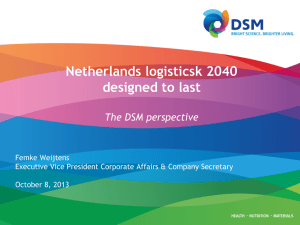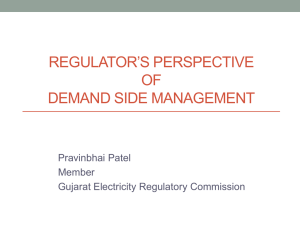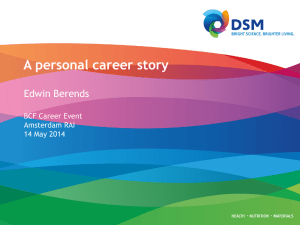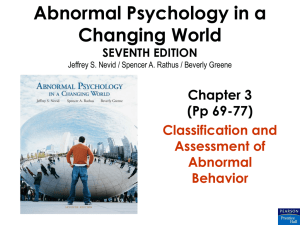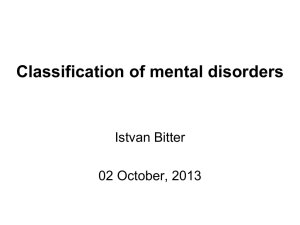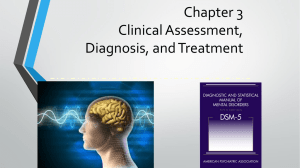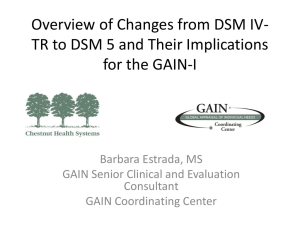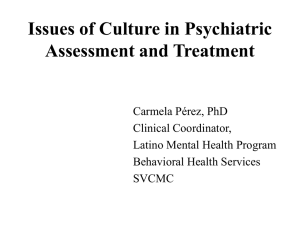DSM 5 - National Association of Social Workers
advertisement
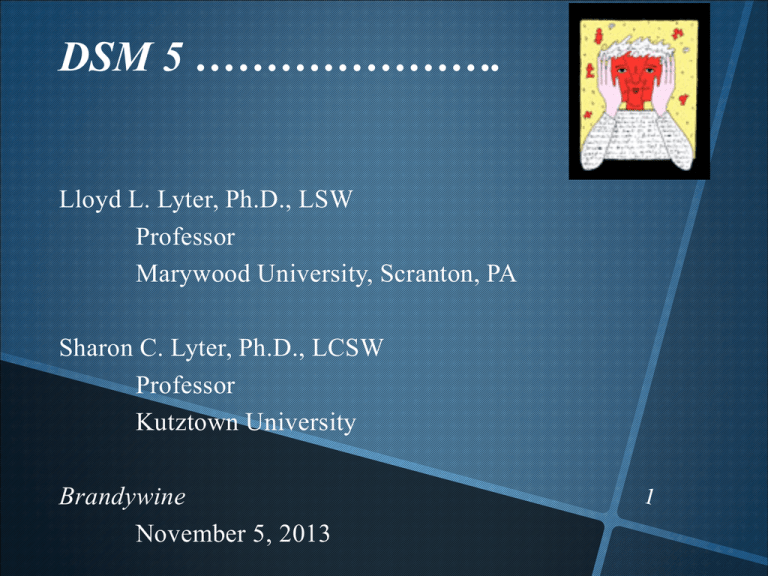
DSM 5 …………………. Lloyd L. Lyter, Ph.D., LSW Professor Marywood University, Scranton, PA Sharon C. Lyter, Ph.D., LCSW Professor Kutztown University Brandywine November 5, 2013 David Kupfer, MD Chair of DSM-5 Task Force Thomas Detre Professor and Chair Department of Psychiatry Professor of Neuroscience Department of Psychiatry Thomas Detre Hall of the Western Psychiatric Institute and Clinic University of Pittsburgh 3811 O'Hara Street Pittsburgh, PA 15213 Dear Dr. Kupfer: We urge you to consider the role of Social Work professionals in the provision of mental health services in the United States and in the development of the upcoming Diagnostic and Statistical Manual of Mental Disorders, DSM-V. As stated by the National Association of Social Workers (NASW) Executive Director Elizabeth J. Clark, the DSM is widely used by social workers. Social workers are one of the largest providers of mental health services in the United States. We ask you to consider the voices of social work providers, represented here by the signatures of attendees at the annual conference of the New Jersey chapter of the National Association of Social Workers. Please consider our request for an active role in the development of the DSM-5. Sincerely, Who are the providers? Which is the largest provider discipline? … social workers psychiatrists psychologists ??? The Primacy of Social Work Social workers provide most of the country’s mental health services. Of mental health professionals … 45% -- social work 5% -- psychiatry 17% -- psychology 24% -- counseling 9% -- marriage and family therapy Both social work and psychology have grown in number of trained mental health professionals in recent years, while psychiatry has remained stable. (Substance Abuse and Mental Health Services Administration, 2012). Where did you learn about DSM – classroom, practicum? How did you learn about the DSM - from social workers? from psychologists? psychiatrists? Quality of learning? How should students be prepared regarding DSM? …. What are the strengths and limitations of DSM? …. Authority to diagnose …. Licensure of educators… Knowledge regarding DSM-5 … DSM Views: What do you know about NIMH? As an indicator of their involvement and interest in the development of DSM-5, participants were asked if they were aware of current efforts by NIMH (National Institutes of Mental Health) with regard to classification systems and, if so, to indicate their understanding. A quarter (26%) of the respondents affirmed that they were aware, but only 4 statements were accurate (i.e., focus on brain research, biomarker identification, NIMH has developed strategic planning around creating new ways to classify and diagnose mental disorders, revising to include neuroscience advances). Most mistakenly believed that NIMH and the APA the same organization. 12 DSM Views: What do you know about NIMH? NIMH director Thomas Insel noted in The Director’s Blog on the NIMH website (2010) that The Diagnostic and Statistical Manual of Mental Disorders has validity problems and, furthermore, that “The Research Domain Criteria (RDoC) is an initiative that will develop neurosciencebased criteria for classifying mental disorders” (para. 4). In 2013, Insel, stated: “That is why NIMH will be re-orienting its research away from DSM categories. Going forward, we will be supporting research projects that look across current categories – or sub-divide current categories – to begin to develop a better system. What does this mean for applicants? Clinical trials might study all patients in a mood clinic rather than those meeting strict major depressive disorder criteria. What does this mean for patients? We are committed to new and better treatments, but we feel this will only happen by developing a more precise diagnostic system. The best reason to develop RDoC is to seek better outcomes.” By Thomas Insel on April 29, 2013 Transforming diagnosis. http://www.nimh.nih.gov/about/director/2013/transformingdiagnosis.shtml 13 Impact of personal experiences with mental illness … Summary of Educator Views Overall, the study participants, social work educators, were licensed clinical professionals, live in states where social work has authority to diagnose, and favored a state level license for all social work educators and a clinical license for those who teach direct practice. They voiced support of all professions named-social work, psychology, and psychiatry-to diagnose. They favored retaining the DSM as it is but preferred that the Social Work profession have a role in developing and updating DSM. They favored incorporation of the strengths perspective and do not believe that DSM is sensitive to person-in-environment and family-in-environment perspectives. However, they agreed that even with its strengths and limitations, students are capable of understanding those nuances of DSM. They noted regard for DSM as an essential tool and a good fit for Social Work practice. They favored altering thresholds such that fewer people would be eligible for a DSM diagnosis of Attention Deficit Hyperactivity Disorder and for Autism. In addition, they would like to retain the grief exclusion under major depressive disorder. They expressed the belief that mental health content should include some DSM content at both BSW and MSW levels and noted, in fact, that this is true at their own schools; most favored giving a basic understanding at the BSW level and teaching to formulate a diagnosis at the MSW and doctoral levels. 15 Despite the fact that Social Work was not represented on the DSM Task Force (as it had been in the past), there are signs of ……….. good news. Contributing psychosocial and environmental factors (previous Axis IV), client person-in-environment, and family-in-environment are now represented in part by: Z-codes and Cultural Formulation Interview 16 ICD-10 Z-Codes Contributing psychosocial and environmental factors or other reasons for visits are now represented through an expanded selected set of ICD9-CM V-codes and, from the forthcoming ICD-10-CM, Z-codes. These provide ways for clinicians to indicate other conditions or problems that may be a focus of clinical attention or otherwise affect the diagnosis, course, prognosis, or treatment of a mental disorder. These conditions may be coded along with the patient’s mental and other medical disorders if they are a focus of the current visit or help to explain the need for a treatment or test. Z-codes include family upbringing, child and adult maltreatment and neglect, and educational, occupational, and housing problems. 17 ICD-10 Z-Codes Z63.4 High expressed emotion level within family. Z63.0 Relationship distress with spouse or intimate partner. T74.31XA Spouse or partner abuse, psychological, confirmed. 18 ICD-10 Z-Codes Z62.29 Upbringing away from parents. Z62.898 Child affected by parental relationship distress. Z63.5 Disruption of family by separation or divorce. Z64.1 Problems related to multiparity. Z64.0 Problems related to unwanted pregnancy. 19 ICD-10 Z-Codes Z60.2 Problem related to living alone. Z59.3 Problem related to living in a residential institution. Z59.2 Discord with neighbor, lodger, or landlord. Z59.0 Homelessness. 20 ICD-10 Z-Codes Z59.5 Extreme poverty. Z59.1 Inadequate housing. 21 ICD-10 Z-Codes Z59.4 Lack of adequate food or safe drinking water. Z60.5 Target of (perceived) adverse discrimination or persecution. 22 ICD-10 Z-Codes Z64.4 Discord with social service provider, including probation officer, case manager, or social services worker. Z75.4 Unavailability or inaccessibility of other helping agencies. Z75.3 Unavailability or inaccessibility of health care facilities. 23 ICD-10 Z-Codes Z56.82 Problem related to current military deployment status. 24 ICD-10 Z-Codes Z65.4 Victim of crime. Z65.4 Victim of terrorism or torture. Z65.0 Conviction in civil or criminal proceedings without imprisonment. Z65.1 Imprisonment or other incarceration. Z65.2 Problems related to release from prison. 25 “Telescoping” and Cross-Cutting Symptom Measure (13 domains for adult) 1. depression 2. anger 3. mania 4. anxiety 5. somatic symptoms 6. suicidal ideation 7. psychosis 8. sleep problems 9. memory 10. repetitive thoughts and behaviors 11. dissociation 12. personality functioning 13. substance abuse 26 “Telescoping” and Cross-Cutting Symptom Measure (12 domains for children 6-17) 1. somatic symptoms 2. sleep problems 3. inattention 4. depression 5. anger 6. irritability 7. mania 8. anxiety 9. psychosis 10. repetitive thoughts or behaviors 11. substance use 12. suicidal ideation/ suicidal attempts 27 Despite the fact that Social Work was not represented on the DSM Task Force (as it had been in the past), there are signs of ……….. good news. Cultural Formulation Interview The word “strength” does not appear, but related terms are: resources, social supports, and resilience. 28 Cultural Formulation Interview Cultural Formulation Interview, DSM-5, pp. 749-759 (interviewer and informant versions with 12 modules). (collaborate with WHO for ICD 11) Should precede the standard diagnostic interview. Designed to be used with EVERYONE! Gender and Cross-Cultural Issues DSM-5 Study Group Neil K. Aggarwal, MD, MBA (Columbia NIMH fellow) Sofie Baarnhielm, MD, PhD (Sweden) 29 Cultural Formulation Interview Cultural Definition of the Problem What do you think are the Stressors and Supports causes? Role of Cultural Identity 30 Cultural Perceptions of Cause … Stressors … Supports Stresses… money … family How would you describe your problem? resources, social supports, and resilience spiritual reason kinds of support that help … support from friends, family… 31 Role of Cultural Identity communities you belong to …. languages you speak… homelessness as culture race … ethnic background … gender … sexual orientation … faith … religion migration-related problems discrimination due to … ? conflict across generations? We all have multiple identities! 32 Self-Coping treatment, help, advice, healing …. most useful … least helpful doctors, helpers, healers folk healing, spiritual counseling, alternative healing, support groups 33 Barriers money, work, family stigma, shaming, discrimination lack of services that understand your background what got in the way? 34 Preferences What do you think would be most useful? social network views What have family, friends suggested? 35 Clinician-Patient Relationship Concerns about client-patient relationship? Racial/ethnic differences, language barriers that may be viewed as barriers… Communication … 36 “Telescoping” of CFI function provided by 12 supplementary modules to use in subsequent sessions. 1. Explanatory Model 2. Level of Functioning 3. Social Network 4. Psychosocial Stressors 5. Spirituality, Religion, and Moral Traditions 6. Cultural Identity 7. Coping and Help-Seeking 8. Patient–Clinician Relationship 9. School-Age Children and Adolescents 10. Older Adults 11. Immigrants and Refugees 12. Caregivers 37 Social work did not hold a key decision-making role in the publication of DSM-5, yet there appears to be a presence of social work themes that exceeds that of earlier editions. Within DSM-5, attention to strengths are not now incorporated within the diagnostic categories themselves, but do appear in the form of the enhanced Z Codes, the Cultural Formulation Interview (in section III – emerging measures and models), and the efforts to incorporate global themes and models, such as WHODAS (World Health Organization’s Disability Assessment Schedule). Social work values are reflected in the elegance of a bio-psychsocio-cultural perspective. 38 Social work’s primacy in mental health may indeed be enhanced given the need for a bio-psychsocio-cultural perspective. 39 NIMH/RODC, APA, NASW …… competition and race for knowledge = knowledge building 40 joint agreement, accord, balance … harmony within interdisciplinary mental health care teams … new level of cooperation, collaboration, and partnership … NASW CEO, Angelo McLain, NASW News, October 2013 41 42
